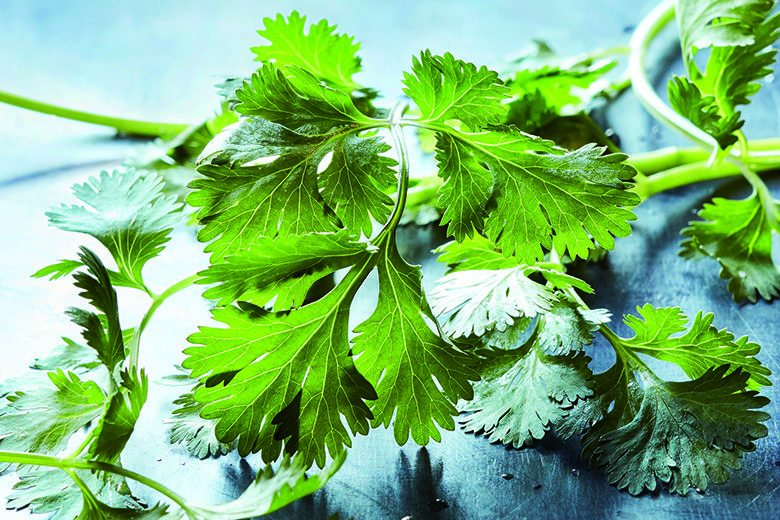
Cilantro (Coriandrum sativum), also known as coriander or Chinese parsley, is a leafy green herb commonly used in Asian, Caribbean, Indian and Latin American cuisine. The entire plant is edible, from leaves to root, but most people tend to favor the raw leaves and seeds. While many love the bright, fresh taste of cilantro, others are genetically predisposed to dislike it, saying it tastes “soapy.”
In the Kitchen
Fresh cilantro’s distinctive flavor fades quickly, so it should be used promptly. Wash and dry fresh leaves before using and store unused cilantro in the refrigerator, ideally with the stems in a glass of water, covered loosely with plastic.
Cilantro leaves usually are added to foods at the end of cooking, except with curry dishes. Spices such as ginger, garlic and curry pair well with this herb.
Dried, ripe fruit of the cilantro plant is known as coriander seed, which can be used whole or ground. Ground seeds are ideal for creating a custom blend of curry spices or to heighten the flavor profile of soups, stews, marinades and compotes. Whole seeds should be added early in the cooking process to provide time for the full flavor to release. Unused coriander seeds can be stored in an airtight container in a cool, dry place.
In the Clinic
One quarter-cup of raw cilantro leaves contains one calorie and less than one gram each of carbohydrate, protein and fat. This small portion contributes about 10 percent of the daily value for vitamin K. Cilantro also delivers phytonutrients, including the carotenoids lutein and zeaxanthin and quercetin, a type of flavonoid called a flavonol.
Several in vitro and animal studies have found a range of potential antimicrobial, antioxidant and anti-inflammatory health benefits from cilantro extracts and essential oils. In addition, cilantro extract has been shown to protect against cellular damage, help treat infections and guard against oxidative stress by absorbing and neutralizing free radicals.
The Natural Medicines Comprehensive Database classifies cilantro as “likely safe” when consumed in amounts commonly used in foods (about ¼-cup serving). In the United States, it is Generally Recognized As Safe for its intended use by the U.S. Food and Drug Administration. However, there is not sufficient reliable evidence to confirm cilantro’s safety when consumed in medicinal applications. Additionally, because of insufficient reliable evidence on cilantro’s safety for pregnant and lactating women, these individuals should avoid “amounts in excess of those found in foods.”
The Natural Medicines Comprehensive Database documents adverse effects of coriander powder, oil and extract including dermatologic conditions such as contact dermatitis, hives and itching; endocrine issues including gastrointestinal discomfort, skin discoloration and mood changes; and anaphylaxis.
In Quantity
For use in foodservice, fresh cilantro is available by the pound, providing about 70 ¼-cup servings. Dried coriander seeds and ground dried coriander also are available by the pound. Cilantro can be purchased frozen, often as a puree or paste or frozen from fresh and trimmed. Frozen cilantro is ideal for sauces, dressings and purees, while the fresh herb can be used as a garnish or accent on dishes such as salads and guacamole. Fresh cilantro should be refrigerated below 40 degrees Fahrenheit, and frozen cilantro should be kept below 0 degrees Fahrenheit.
Check out the recipes that accompanied this Savor feature: Cilantro Chimichurri Fries and Tofu “Ceviche” with Chili Lime Tortilla Chips.






